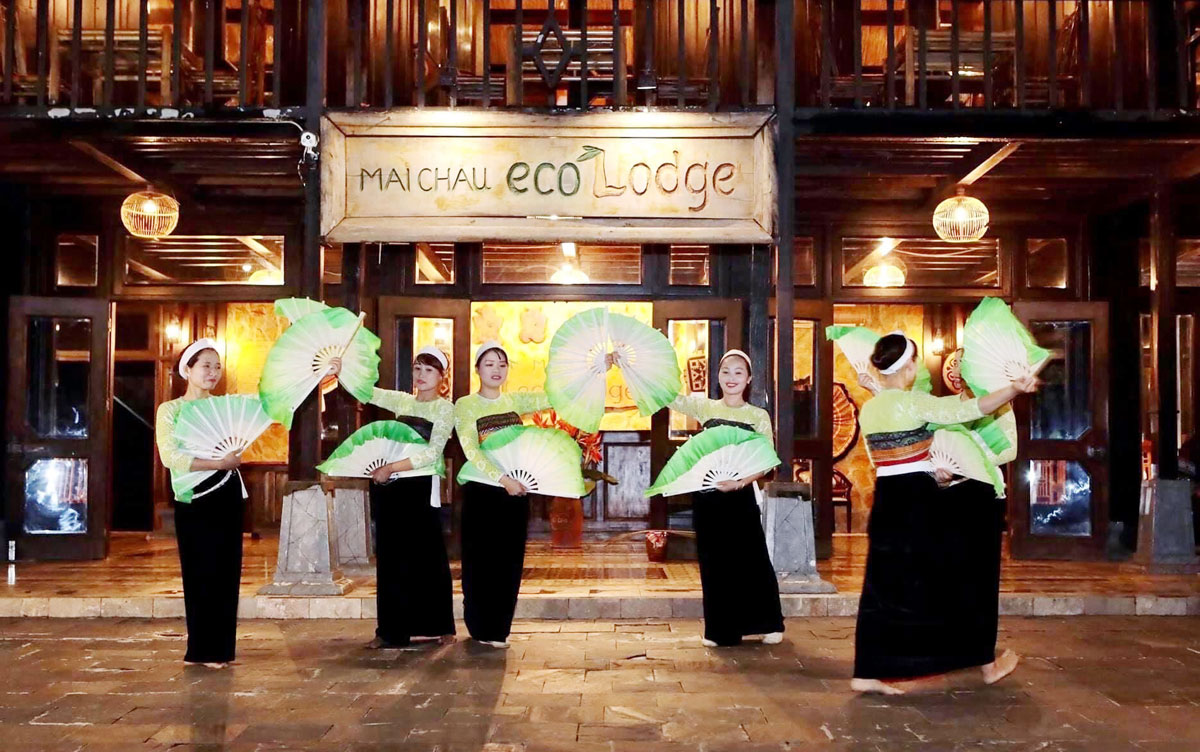



The performance team at Mai Chau Ecolodge resort in Na Phon commune, Mai Chau district is showing Xoe dancing with fans to serve tourists.
Enjoying Xoe dancing
Arriving in Mai Chau valley in the shadow of the twilight, Ms. Ha Thi Nhung - a white Thai girl with a pretty face led us to a spacious stilt-house in the middle of the village. After the social greeting, the owner and guests sat down on the tray of rice. The tray is full of the specialties of Thai people: the smoked-dried meat, five-color sticky rice, grilled fish, wild vegetables ... and a cup of wine, the story between the owner and the guests became closer and more friendly.
Thai girls are dressed in Com blouses and velvet dresses, holding hands in a circle, moving in circles around the fire in the earnest lyrics: "You arrive in Mai Chau when spring comes ... this night Can wine makes people to be in love with people, Thai girls with a bright smile in the light of pink fire and rosy cheeks ... ”. The circle grew bigger and bigger, the hands are tightly holding up and down and it is sometimes near and far from the fire. The circle was bigger and bigger, as the number of people joining in was larger, because few people could refuse the young girls' sincere invitation: "Don't be afraid of being drunk, my ivory hands, my full cup, my full cup…”. Beside the flickering fire, the strangers suddenly became acquainted, many people who had never spread did not hesitate to hold hands together, harmonizing with the dance.
"Xoe dancing, when Xoe dancing appeared, it has been as fascinating as it used to be”. It was just like the words in the song "Xoe dancing loves each other” by the musician Vương Khon, and no one knows exactly when Xoe dancing appeared. Born and raised in Mai Chau, living and sticking with the cradle of Thai people in Hoa Binh, Ms. Ha Thi Nhung can dance very nicely, she shared: Since early birth, each Thai ethnic person has been raised and grown up with Xoe dancing. Xoe dancing plays an important role in the spiritual life of the people. Xoe dancing of Thai is not only beautiful in art but it also has a good humanity, demonstrating the spirit of community cohesion, creating a special attraction, making people enter the show whether it is big, small, strange, familiar, they no sooner or later feel just like in the beginning.
Connecting Xoe dancing forever
Nhung explained: "Xòe” in Thai means dancing. Xoe of Thai ethnic people has been understood as the art of performing folk dances of Thai ethnic people with the participation of many people and without the limit of the number. For a long time, Xoe art has entered the literature and the poetry to preserve and describe a culture that is rich in identity and unique beauty.
To understand more about Xoe dancing, Ms. Nhung led us to the house of the artist Ha Uom - a "living museum” of Thai culture in Mai Chau. He explained clearly: Due to living in the midst of majestic nature, along with industriousness and the creative spirit in the conquest of nature, Thai people often hold hands around the fire and dance to celebrate every time they complete a great task. As a result, Xoe dancing has been formed. All of Xoe dances are simulating the steps of great grandfather when clearing land, clearing fields, growing rice, taking water, throwing towels, inviting wine ... All vividly and subtly express life, expressing dreams and thirst of Thai ethnic people in the Northwestern area. Therefore, on every occasion of holiday, Tet or on a happy day of the family line, the family, the village, especially when the house welcomes guests ..., Xoe circle is often held as a ritual. According to the artisan Ha Uom, the soul of Xoe of Thai ethnic people exits in the ancient Xoe dancing, such as: Xoe dancing with scarfs, Xoe dancing with fans, Xoe dancing with bamboo... in which the most popular and appeared the earliest is Xoe dancing in a circle.
For a long time, the old artisans in Mai Chau have always thought of ways to preserve the ancient dance, which is the soul of Thai ethnic people. With their enthusiasm, they teach their children and grandchildren every gesture and dance. That is also the explanation of the head of Lac village – Mr. Ha Cong Hong when we wondered about the organizational ability and professional performance level of the village entertainment teams. He added: In Lac village, there are dozens of teams of Xoe dancing and amateur entertainment. The actors are all the people in the village, they have tought each other how to dance or the staff from the district’s Cultural Office have instructed and trained them. Moreover, this is also a folk- art form that has been recognized as a national intangible cultural heritage and now researchers and artisans are completing a dossier to request UNESCO to recognize it as the heritage of the intangible culture of humanity. Therefore, preserving, promoting and extending it are not only the responsibility, but it is also the pride of each resident of Thai ethnic group.